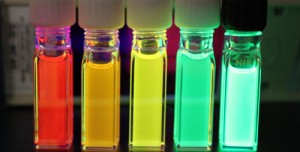There’s a very interesting Jan. 8, 2015 essay by Dr. Andrew Maynard, being hosted on Nanowerk, about the effects that quantum dot televisions could have on the environment (Note: A link has been removed),
Earlier this week, The Conversation reported that, “The future is bright, the future is … quantum dot televisions”. And judging by the buzz coming from this week’s annual Consumer Electronics Show (CES) that’s right – the technology is providing manufacturers with a cheap and efficient way of producing the next generation of brilliant, high-definition TV screens.
But the quantum dots in these displays also use materials and technologies – including engineered nanoparticles and the heavy metal cadmium – that have been a magnet for health and environmental concerns. Will the dazzling pictures this technology allow blind us to new health and environmental challenges, or do their benefits outweigh the potential risks?
If I understand things rightly, cadmium is toxic at both the macroscale and the nanoscale and Andrew goes on to describe quantum dots (cadmium at the nanoscale) and the problem they could present in his Jan. 7, 2015 essay on The Conversation,also hosted by Nanowerk, (Note: Link have been removed),
Quantum dots are a product of the emerging field of nanotechnology. They are made of nanometer-sized particles of a semiconducting material – often cadmium selenide. About 2,000 to 20,000 times smaller than the width of a single human hair, they’re designed to absorb light of one color and emit it as another color – to fluoresce. This property makes them particularly well-suited for use in products like tablets and TVs that need bright, white, uniform backlights.
… What is unique about quantum dots is that the color of the emitted light can be modified by simply changing the size of the quantum dot particles. And because this color-shifting is a physical phenomenon, quantum dots far outperform their chemical counterparts in brightness, color and durability.
Unfortunately, the heavy metal cadmium used in the production of many quantum dots is a health and environmental hazard.
…
On top of this, the potential health and environmental impacts of engineered nanoparticles like quantum dots have been raising concerns with toxicologists and regulators for over a decade now. Research has shown that the size, shape and surface properties of some particles influence the harm they are capable of causing in humans and the environment; smaller particles are often more toxic than their larger counterparts. That said, this is an area where scientific understanding is still developing.
Together, these factors would suggest caution is warranted in adopting quantum dot technologies. Yet taken in isolation they are misleading.
The essay describes the risk factors for various sectors (Note: A link has been removed),
The quantum dots currently being used in TVs are firmly embedded in the screens – usually enclosed behind multiple layers of glass and plastic. As a result, the chances of users being exposed to them during normal operation are pretty much nil.
The situation is potentially different during manufacturing, when there is a chance that someone could be inadvertently exposed to these nanoscopic particles. Scenarios like this have led to agencies like the US National Institute for Occupational Safety and Health taking a close look at safety when working with nanoparticles. While the potential risks are not negligible, good working practices are effective at reducing or eliminating potentially harmful exposures.
End-of-life disposal raises additional concerns. While the nanoparticles are likely to remain firmly embedded within a trashed TV’s screen, the toxic materials they contain, including cadmium, could well be released into the environment. Cadmium is certainly a health and environmental issue with poorly regulated e-waste disposal and recycling. However, when appropriate procedures are used, exposures should be negligible.
It seems quantum dot televisions impose a smaller burden than their cousins on the environment,
Although it seems counter-intuitive, analysis by the company that was made available to the EPA [US Environmental Protection Agency] showed QD Vision’s products lead to a net decrease in environmental cadmium releases compared to conventional TVs. Cadmium is one of the pollutants emitted from coal-fired electrical power plants. Because TVs using the company’s quantum dots use substantially less power than their non-quantum counterparts, the combined cadmium in QD Vision TVs and the power plant emissions associated with their use is actually lower than that associated with conventional flat screen TVs. In other words, using cadmium in quantum dots for production of more energy-efficient displays can actually results in a net reduction in cadmium emissions.
Not the conclusion one might have drawn at the outset, eh? You can read the essay in its entirety on either Nanowerk (Jan. 8, 2015 essay) or The Conversation (Jan. 7, 2015 essay). (Same essay just different publication dates.) Andrew has also posted his essay on the University of Michigan Risk Science Center website, Are quantum dot TVs – and their toxic ingredients – actually better for the environment? Note: Andrew Maynard is the center’s director.
